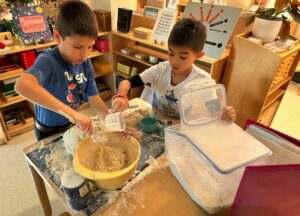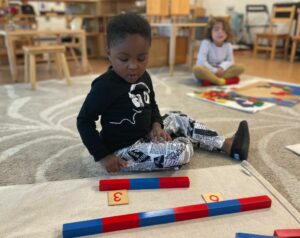By Sasha Rogelberg

In the aftermath of the pandemic, private schools have weathered the challenge of COVID well. Often with more funding than public schools, private schools tout certain advantages to families, such as being able to tailor instruction and curricula to their students to provide quality education.
“Our class sizes are smaller, resources are higher,” says Jon Kidder, head of school for Barrie School, a Silver Spring, Maryland -based independent school. “All the things that all children should have, we are able to provide.”
If you’re a parent who is set on private school education for your child, it might seem like the choice is made, but there’s still plenty to consider. What’s the best fit for your child — parochial or secular, single gender or co-educational? Below are some explanations of different private school models to help you make the best decision.
Montessori
If you want your child’s private school education to start at a very young age, chances are you’ll stumble across several Montessori programs.
The Montessori philosophy, developed by Italian physician Maria Montessori in the early 1900s, prioritizes children developing their own interests and independence through practical play.
At Aidan Montessori School in Washington, D.C., children 18 months old through sixth grade learn both functional skills and more traditional school subjects.
“We’re really focusing on the whole child and how they can build themselves,” says Jamie Rue, Aidan’s head of school. “And we provide the environment and the highly-trained teachers to know just how to support them at the right moment in their development.”
Aidan students are divided into three groups — primary, lower elementary and upper elementary — based loosely on age and ability level. The school day is scaffolded with plenty of options for play at a given time, with teachers giving instructions to small groups of children who express interest in a given subject.
Generally, Montessori schools promote larger class sizes with high student-teacher ratios. The framework encourages students to learn from one another and explore a wide breadth of subjects, and larger classes allow students to form small groups themselves.
Elementary students also participate in the Going Out program, where students plan their own field trip excursions, such as to Rock Creek Park or the International Spy Museum, both in D.C. They plan their own curriculum to help develop a sense of social purpose and responsibility.
“They’re actually from soup to nuts or from A to Z developing their own curriculum to something that they’re interested in,” says Aidan Director of Admissions & Enrollment Management Japera Walker Wilkison.
What about Reggio Emilia and Waldorf?
There are some alternatives to the Montessori pedagogy, though many stem from the same constructivist philosophy. Similar to Montessori, the Waldorf approach prioritizes independence and initiative, but takes a “thinking, feeling and doing approach” through multisensory learning to promote creative thinking.
The Reggio Emilia pedagogy encourages curiosity and welcomes different interpretations and uses for toys and objects. Unlike Montessori, Reggio Emilia schools have small class sizes with high student-teacher ratios in order to encourage collaboration between teachers, and between teachers and students.
Progressive
As your child gets older, you likely won’t find many Montessori options, but there are still opportunities for hands-on, student-led learning.
The Barrie School, for example, describes itself as a progressive independent school, drawing from the philosophies of Montessori and John Dewey, both of whom believed in school as a place for the development of a social identity. Dewey, however, also believed in education as a place for social reform, a value reflected at Barrie, which Kidder called the first racially integrated school in the broader D.C. area.
“That’s not politically progressive — that’s educationally progressive,” Kidder says. “The foundation of that is about equity and access, and that when you come into one of our classrooms, it looks like the United Nations.”
The elementary program at Barrie is Montessori-based, but Barrie also grants middle and high school students opportunities to learn outside of the school’s walls through project-based learning. Students visit the Sea of Cortez in Baja, California, to study climate change at a research center, each with their own research questions. Tenth graders visit Iceland to expand their study of Viking history.
“[The trips] bond those students together, and we know from neuroscience that kids that are connected socially are able to learn at a higher level,” Kidder says.
Independent

Progressive schools such as Barrie can fall under a bigger umbrella of independent private schools — institutions that do not receive government funding and are overseen by a board of trustees or governors. Each has its own unique philosophy and culture.
Kidder encourages parents to explore what schools are out there to find the best fit.
“There’s always going to be that just right school for your child. It may be at Barrie. It may be at another place — public or independent,” he says. “And I always say to parents, trust your gut.”
Parochial
For children from families with strong religious values or communities, parochial school could be a good fit. While “parochial” usually denotes a Catholic affiliation, the term simply refers to any school with a religious foundation, including Episcopalian, Jewish, Muslim and others.
Regardless of your faith, consider that religious elements will likely be incorporated into your child’s school day if you choose to send them to a parochial school.
Catholic schools
This is certainly the case at The Avalon School, a Catholic school in Wheaton, Maryland, which serves students in kindergarten through high school.
“It’s kind of the air we breathe,” says Head of School Kevin Davern of the role of Catholicism at Avalon.
Students participate in a prayer before class and can opt into daily mass. But Catholicism is also at the cornerstone of why Avalon leadership believe in the power of education.
“The natural world is good because God created it. People have an intrinsic dignity …God’s given us the ability to know meaningful things about the world and history, and we should pass them on,” Davern says.
Single-gender schools
The Avalon School, which is a coordinate school with Brookewood School in Kensington, Maryland, is also unique in that it is an all-boys school, while Brookewood is all girls.
The single-gender school experience allows for the school day to be tailored to students’ needs. Boys, for example, need more time to run around, Davern says, so the Avalon school day incorporates plenty of breaks and changes to go outside.
However, having single-gender schools also eliminates gender expectations for what students take interest in or study. At Avalon, boys can enjoy art without feeling like it is an activity solely for girls. At Brookewood, students can study math and science without comparing their interests to their male counterparts.
What about costs?
Private schools can be expensive, and cost is dependent on the school and age of the student. For young students in a half-day program at Avalon, for example, families can expect to pay about $4,500 annually. If you have a high schooler interested in attending Barrie, it may cost up to $36,210 per year.
However, schools often offer financial aid packages based on income for families unable to pay full tuition for their students.







